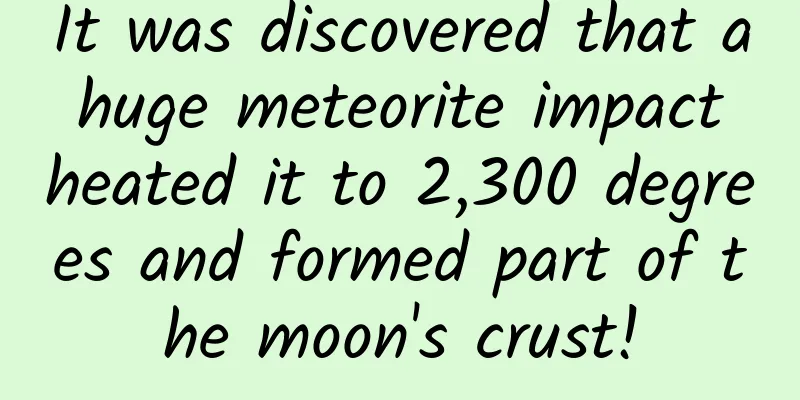It was discovered that a huge meteorite impact heated it to 2,300 degrees and formed part of the moon's crust!

|
[Mobile software: Bo Ke Yuan] A new study published in the journal Nature Astronomy reveals that a destructive event, which is often associated with disaster movies and the extinction of dinosaurs, may also be one of the reasons for the formation of the lunar surface. A team of international scientists led by the Royal Ontario Museum has found that the formation of ancient rocks on the moon may be directly related to large-scale meteorite impacts. Scientists have conducted a new study on a unique rock that NASA astronauts brought back to Earth during the Apollo 17 moon landing mission in 1972. The study found that it contains mineralogical evidence that it was formed at incredibly high temperatures (over 2,300 degrees Celsius/4,300 degrees Fahrenheit), which could only be achieved by the melting of the planet's outer layers during a large impact event. Within the rock, the researchers found the former presence of cubic zirconia, a mineral phase that is often used as a substitute for diamonds in jewelry. This phase only forms in rocks heated to over 2,300 degrees Celsius, and although it later reverted to a more stable phase (a mineral called clinodite), the crystals retained evidence of a unique high-temperature structure. An interactive image of the complex crystals used in the study can be seen here using a virtual microscope. While observing the crystal structure, the researchers also measured the age of the grains, which revealed that the truncatite was formed more than 4.3 billion years ago. The study concluded that the high-temperature cubic zirconia phase must have formed before this, indicating that large impacts were crucial to the formation of new rocks on the early Moon. 50 years ago, when the first samples were brought back from the lunar surface by the Apollo moon landings, lunar scientists raised questions about how the rocks of the lunar crust were formed. To this day, a key question remains unanswered: How did the moon's outer and inner layers mix after it formed? Now, new research suggests that a large impact 4 billion years ago may have driven that mixing, producing the complex range of rocks seen on the lunar surface today. Rocks on Earth are constantly recycled, but the moon does not exhibit plate tectonics or volcanism, which has allowed older rocks to be preserved. By studying the moon, scientists can better understand the earliest history of our own planet. If large, super-hot impacts formed rocks on the moon, the same process may have occurred on Earth. Dr Ana Cernok, a Hatch Postdoctoral Fellow at the ROM and co-author of the study, said: "When I first saw the rock, I was struck by how different the minerals looked compared to other Apollo 17 samples. Although less than a millimetre across, the truncatite grain that caught our attention is the largest I've ever seen in an Apollo sample. This small grain still holds evidence for the formation of an impact basin hundreds of kilometres in diameter. This is important because there is no evidence of any of these ancient impacts on Earth." Study co-author Dr James Darling of the University of Portsmouth said: "These findings completely change scientists' understanding of the samples collected during the Apollo missions, and indeed of the lunar geology, showing that these incredibly violent meteorite impacts helped build the lunar crust, rather than just destroying it." Bo Ke Yuan | Research/Source: Royal Ontario Museum The study was published in the journal Nature Astronomy BoKeYuan|Science, technology, research, popular science Follow [Bokeyuan] to see more beautiful cosmic science |
<<: To observe the sky, you need a favorable location. Where is the best home for a telescope?
>>: Dreaming about Zhongshan: Migrating to the West
Recommend
Android 9.0 upgrade is too slow, Google wants users to test Android Q directly
Although after Google released Android 9.0 this y...
Midas Touch "Live Flow Control Master" analyzes and understands traffic control, full of practical information
Midas Touch Live Streaming Controller, a comprehe...
APP can no longer produce dark horses. All fields are becoming saturated.
Not long ago, the industry announced the third qu...
Geek Park: Alibaba Cloud and Huawei Cloud were successfully selected for the 2023 "China Innovation Force 50 List (InnoForce 50)"
Recently, Geek Park, China's largest innovato...
Brazil's Vice President welcomes Huawei's participation in the country's 5G bidding (with original text)
Brazil's Vice President welcomes Huawei to pa...
Baijiahao earns millions a month, is it really that easy to make money on other platforms?
The 5th anniversary of the official account has j...
A brief talk about how products resonate with users!
As an operator or marketer, how can you use the h...
Electric driverless cars are running at a speed of up to 350 kilometers per hour
DevBot is an electric self-driving car that was r...
Let robots learn "common sense" by themselves? They can correct themselves and complete complex household chores without humans!
Robots are excellent human imitators, but most of...
Neijiang Property Mini Program investment price inquiry, how much is the Neijiang Property Mini Program investment price?
How much does it cost to attract investment throu...
LeEco's car factory broke ground three years ago, and with 70 billion yuan invested, it still hasn't made it to the top three?
Like Ms. Dong, Jia Yueting, CEO of LeEco Holdings...
The Android version of Mailbox is in a big PK. Mailbox Master beats the Android built-in Mailbox in seconds
For office workers, sending and receiving emails ...
Dark color vs. light color, which umbrella is more sun-proof?
The most frustrating thing about summer is that e...
Microsoft Surface Pro 3 receives heavyweight recognition, sales surge expected
Data released by relevant market research institu...
APP user operation: analysis of user growth system, with 6 major cases!
For the idea of writing, please refer to the fo...







![Efficient employment class for emotional counselors, achieving a side job with a monthly income of 50,000+ [audio course]](/upload/images/67cc339626c72.webp)

